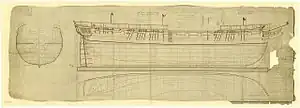| History | |
|---|---|
| Name | HMS Hotspur |
| Builder | Parsons |
| Launched | 13 October 1810 |
| Fate | Broken-up in January 1821 |
| General characteristics | |
| Class and type | Fifth-rate 36-gun frigate |
| Tons burthen | 952 bm |
| Length | 145 ft 0 in (44.2 m) |
| Beam | 38 ft 6 in (11.7 m) |
| Sail plan | Full-rigged ship |

HMS Hotspur was 36-gun Fifth-rate frigate of the Royal Navy. Built by Parsons of Warsash and launched on 13 October 1810.
Career
On 25 August 1811, Hotspur and Barbadoes captured Eseperance, of Havre de Grace, and Guillaume Chorede (or Guillaume Chere), from Cherbourg, both laden with timber. The captured vessels arrived in Portsmouth.[1][2]
On 30 April 1812 Sir William Bensley, Sovereign, Harriet, and City of London were at 25°40′N 23°5′W / 25.667°N 23.083°W and under escort by Hotspur, which parted from them and returned to England.[3] The East Indiamen had left England and were on their way to the East Indies.
In 1813 Hotspur was in Buenos Aires under the command of Captain Josceline Percy, the younger son of the Duke of Northumberland.[4] This is where George Pegler, an English boy of about 14 joined the crew, having escaped from the crew of a merchant ship. Leaving, Buenos Aires, Horatio anchored for a while off the coast of Montevideo, near Isla de Flores, which the crew named Seal Island for the vast numbers of South American fur seals. Parties of 100 or more sailors from Horatio would land on the island every day to hunt the seals.[4] After this, the frigate sailed for Rio de Janeiro and Portsmouth.[4]
On 26 October 1813, Hotspur and Pyramus captured the 225-ton (bm) American letter of marque Chesapeake off Nantes. Captain Joseph Richardson had sailed Chesapeake from America to France and she left Nantes on 18 October 1813.[5][Note 1]
On 25 November the French frigate Sultane and another frigate in company captured Little Catherine as she was sailing from Passages. The French took off Little Catherine's crew and abandoned her. On 28 November Hotspur picked her up at sea.[Note 2]
Fate
Hotspur was broken up in January 1821.[8]
Notes
Citations
- ↑ "No. 16774". The London Gazette. 14 September 1813. p. 1837.
- ↑ "The Marine List". Lloyd's List. No. 4593. 30 August 1811. hdl:2027/hvd.32044105232920. Retrieved 24 January 2021.
- ↑ Lloyd's List №4672.
- 1 2 3 Pegler, George (1879). Autobiography of the Life and Times of the Rev. George Pegler. Wesleyan Publishing House. pp. 105–106.
- ↑ Cranwell & Crane (1940), p. 157.
- ↑ Cranwell & Crane (1940), p. 377.
- ↑ "No. 17149". The London Gazette. 29 June 1816. p. 1252.
- ↑ Winfield (2008), p. 167.
References
- Cranwell, John Philips; Crane, William Bowers (1940). Men of marque; a history of private armed vessels out of Baltimore during the War of 1812. New York: W.W. Norton & Co.
- Erickson, Paul A. (1986) Halifax's North End: an anthropologist looks at the city. (Lancelot Press)
- Winfield, Rif (2008). British Warships in the Age of Sail 1793–1817: Design, Construction, Careers and Fates. Seaforth Publishing. ISBN 978-1-86176-246-7.